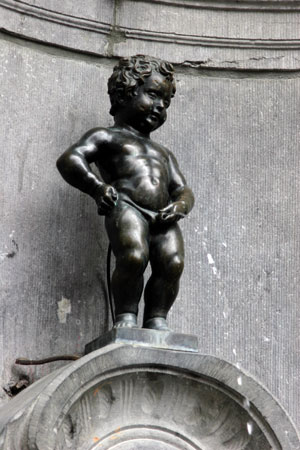
Brussels, Belgium 1388. A document from the archive of the Cathedral of Santa Gudula mentions for the first time the famous monument Manneken Pis. We do not know exactly who and when he made the sculpture, but it was stolen several times over the centuries, and that the state mentioned in that document is not what you can see today. In 1619, the artist Jerome Duquesnoy, father of the famous sculptor François Duquesnoy, made a new bronze statue. But the boy's adventures praying had not ended. 1695
The citizens of Brussels had to protect the statuette from the siege of the French. Since then, Manneken Pep has the inscription:In petra exaltavit me, et nunc exaltavi caput meum super inimic meos. In the 1960s, however, they were unable to protect themselves from thieves. There are those who say that Duquesnoy's work was finally recovered, which is a replica in the old town, on the corner of the streets Ehaya and Chene, a statue close to Grand Place.
In the absence of knowing the exact origin of the urinal, several legends have been opened to explain the reason of the State.
One day, the enemies besieged the city and placed a powerful explosive device to knock down the walls. A boy named Juliaanske saw that they lit the wick, quickly climbed up to the wall, and urinating on top of it, shut it down to save the city.
Another legend brings us to 1142, the battle of Ransbek. Godofredo, from Lorena, had tied his son's crib to the branches of an oak tree to infuse value to the soldiers. The girl, from above, prayed on her enemies.
According to the most esoteric version, on one occasion the son of a noble from Brussels left a procession because of his roasting character. Carefree, he did things on the corner of a witch's house, and the witch turned it into a statue.
The last legend has a rich merchant and his son as the protagonist. One day, the merchant lost his son and his father offered whoever found him a considerable reward. The efforts of the neighbors proved fruitless, as hours later it was the father himself who found the child urinating in a garden. Not knowing who to pay him, he spent the money on a statue of his son and offered the monument to the citizenry to thank them for their effort.
Washington, D.C., June 17, 1930. The U.S. Congress passed the Tariff Act. It is also known as the Smoot-Hawley Act because it was promoted by Senator Reed Smoot and Representative Willis Hawley.
The law raised import tax limits for about 900 products by 40% to 60% in order to... [+]
During the renovation of a sports field in the Simmering district of Vienna, a mass grave with 150 bodies was discovered in October 2024. They conclude that they were Roman legionnaires and A.D. They died around 100 years ago. Or rather, they were killed.
The bodies were buried... [+]
My mother always says: “I never understood why World War I happened. It doesn't make any sense to him. He does not understand why the old European powers were involved in such barbarism and does not get into his head how they were persuaded to kill these young men from Europe,... [+]
Until now we have believed that those in charge of copying books during the Middle Ages and before the printing press was opened were men, specifically monks of monasteries.
But a group of researchers from the University of Bergen, Norway, concludes that women also worked as... [+]
Florentzia, 1886. Carlo Collodi Le avventure de Pinocchio eleberri ezagunaren egileak zera idatzi zuen pizzari buruz: “Labean txigortutako ogi orea, gainean eskura dagoen edozer gauzaz egindako saltsa duena”. Pizza hark “zikinkeria konplexu tankera” zuela... [+]
Ereserkiek, kanta-modalitate zehatz, eder eta arriskutsu horiek, komunitate bati zuzentzea izan ohi dute helburu. “Ene aberri eta sasoiko lagunok”, hasten da Sarrionandiaren poema ezaguna. Ereserki bat da, jakina: horra nori zuzentzen zaion tonu solemnean, handitxo... [+]
Linear A is a Minoan script used 4,800-4,500 years ago. Recently, in the famous Knossos Palace in Crete, a special ivory object has been discovered, which was probably used as a ceremonial scepter. The object has two inscriptions; one on the handle is shorter and, like most of... [+]
Londres, 1944. Dorothy izeneko emakume bati argazkiak atera zizkioten Waterloo zubian soldatze lanak egiten ari zela. Dorothyri buruz izena beste daturik ez daukagu, baina duela hamar urte arte hori ere ez genekien. Argazki sorta 2015ean topatu zuen Christine Wall... [+]